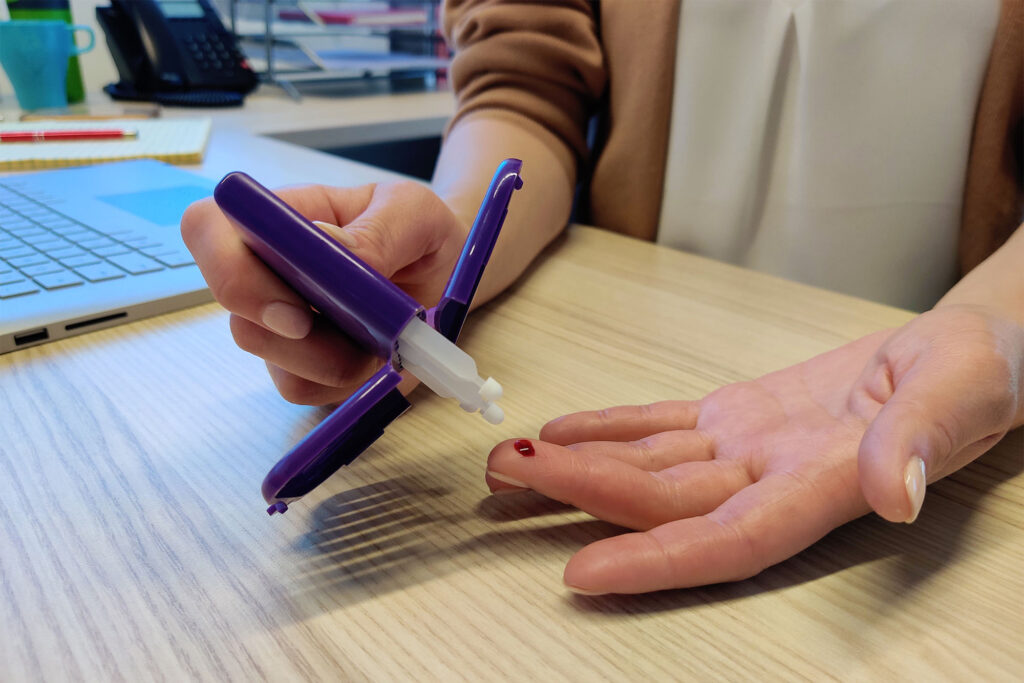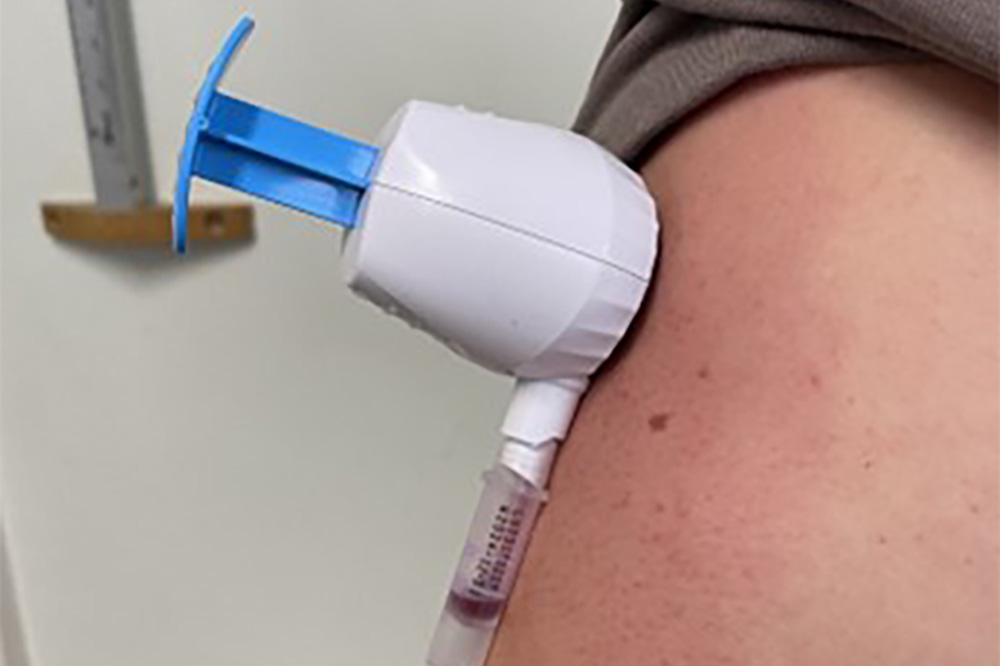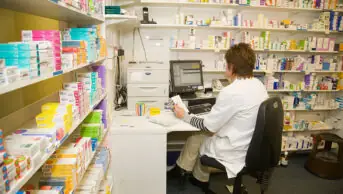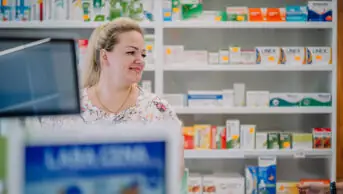Having a blood sample taken, usually by a phlebotomist in a clinic, is an often unpleasant but necessary step in monitoring medical conditions and some medicines. However, Neil Spooner, bioanalyst and co-founder and chair of the not-for-profit Patient Centric Sampling Interest Group, hopes that, for some patients, this will be replaced by blood microsampling.
“At the moment, with traditional venous phlebotomy, it’s all driven by the needs of the analytical lab making the measurement of the sample,” he says, when the focus should be on putting patients’ needs first.
Spooner’s group aims to develop and promote the use of patient-centric sampling technologies, including several recent technologies, allowing for smaller blood samples to be analysed. “The samples can be collected in locations away from the traditional clinic and don’t necessarily need a healthcare professional or phlebotomist to do that,” he explains.
A conventional venous blood test extracts about 5ml of blood, whereas microsampling methods take less than 100µL, often from a finger prick, but also using new devices that are designed to take smaller samples in a painless way. This means patients “can self-sample, at home, or wherever they want to be”, explains Cathy Cordova, vice-president of clinical solutions at Australia-based Trajan Scientific and Medical, which produces several microsampling devices.
Microsampling methods
The most basic microsampling methods start with a finger prick and collect the blood as a dry spot on paper. “The dried sample is so much easier to handle, you just dry it and pop it in the post, it’s not a biohazard and, generally, the analytes are stable,” says Phillip Morgan, consultant clinical scientist at King’s College Hospital in London.
When used to monitor drug concentration in patients’ blood, any drug molecules that are present tend to bind to proteins and will be stabilised in the dry spot, which can be re-solubilised for analysis. Devices are also available to collect liquid microsamples that remain stable for several days and can be shipped to an analytical laboratory.
Trajan recently acquired microsampling market leader Neoteryx, based in California, which produces the Mitra device, based on volumetrically accurate microsampling (VAMS) technology. The VAMS tip is made from hydrophilic polymeric material. “This ‘precision sponge’ rapidly and volumetrically absorbs a specific, precise volume of biological fluid, and the fluid is dried,” explains Cordova. The company says the consistent blood volume allows for more accurate analysis than other dried blood spot methods.

Trajan Scientific and Medical
Karen Perkins, principal clinical biochemist at University Hospitals of Morecambe Bay NHS Foundation Trust, has experimented with touch-activated phlebotomy (TAP), a push-button blood collection device from Massachusetts-based company YourBio Health.
“We’ve gone with the TAP because it’s painless,” says Perkins. It takes up to 900µL of blood from the upper arm, using microneedles thinner than an eyelash, and then applies a vacuum to the skin to draw blood from the punctures. The blood is mixed with an anticoagulant in a reservoir to prevent clotting.
We’ve done quite a bit of work in our lab, looking at a test menu and comparing results obtained against a standard venipuncture sample
Karen Perkins, principal clinical biochemist at University Hospitals of Morecambe Bay NHS Foundation Trust
The samples collected by these methods come from capillaries rather than the standard venous blood collected by a phlebotomist. “Most of the studies that I’ve seen so far show that there’s no difference actually,” says Morgan. However, anything being measured needs to be calibrated against results from conventional blood tests. “We’ve done quite a bit of work in our lab, looking at a test menu and comparing results obtained against a standard venipuncture sample,” says Perkins.
Therapeutic drug monitoring
Microsampling could have a significant impact in therapeutic drug monitoring, given the many medicines for which levels need to be carefully titrated and monitored. One of the most promising uses is to analyse levels of immunosuppressant drugs, such as tacrolimus, which prevent organ rejection in transplant patients. Morgan has been championing the approach at King’s College Hospital, which specialises in liver transplants.
“The drugs themselves are very toxic, and obviously you don’t want to give so much that you poison the patient, but also you don’t want to give so little that you risk losing the transplanted organs,” he explains.
“The best way, so far, that we have to actually customise the dose to the patient is to actually measure the concentration in blood.”
The blood tests are usually done in an outpatient clinic, initially on a weekly basis, which means immunocompromised transplant patients may have to travel to hospital by public transport, potentially exposing themselves to infections. With microsampling, patients can take the samples at home.
Another therapeutic area for which it is important to monitor drug levels is antipsychotic medicines — in particular, clozapine, which is prescribed for schizophrenia when first-line treatments have failed. Around 40% of patients with treatment-resistant schizophrenia will respond to clozapine, but it can have serious side effects. In up to 0.8% of patients, agranulocytosis — which leads to a large drop in neutrophil levels that may result in sepsis and can prove fatal — can develop in the first two months after initiation. Consequently, patients started on clozapine need to have their blood counts monitored weekly.
Matthew Atkins, clinical lead for pathology, point-of-care testing and phlebotomy at Oxford Health NHS Foundation Trust, explains that the need for constant blood tests puts people off starting clozapine and is the main reason why patients choose to discontinue it. This can result in patients staying in psychiatric-intensive care units for months or even years. Even for patients who choose to have regular blood tests, under the current system it can take several weeks to get the results from a laboratory, often extending hospital stays until the physician is sure the drug level is correct.
We decided to implement microsampling across the psychosis care pathways at South London and Maudsley
Matthew Atkins, clinical lead for pathology, point-of-care testing and phlebotomy at Oxford Health NHS Foundation Trust
In 2019, in his previous role at South London and Maudsley NHS Foundation Trust, Atkins began to look at microsampling methods for monitoring clozapine and aripiprazole, a first-line antipsychotic, based on finger pricks and several new handheld analytical devices. He carried out some pilot studies to validate the results against traditional venous blood samples.
A study of 309 patients published in 2021 compared clozapine concentrations in venous blood analysed using standard laboratory methods with finger prick samples analysed using a handheld device — and showed a strong positive correlation between the results1.
In 2023, another study of 226 patients tested a different commercial handheld device that measures full blood count in five minutes from 40µL of finger-prick capillary blood2. The device aligns the blood cells into a single layer and uses an AI algorithm to classify them. Once again, the results were comparable with those from venous blood samples.
Atkins says the feedback he got from patients was incredibly positive, “to such an extent that we decided to implement it across the psychosis care pathways at South London and Maudsley”. It meant that patients could be sampled at home — by clinical staff, not patients — allowing them to avoid the anxiety of attending a clinical setting.
As results are instant, it has the added advantage of making patients more aware of their own blood levels and how that may directly correlate to how they are feeling. “[It’s] opened up a whole new dialogue between patients and clinicians, which was never had in the past,” says Atkins.
Other use cases
For some groups of patients, the option to use microsampling for standard blood tests, such as liver function, blood sugar or cholesterol, could also be a game-changer. Perkins has rolled out a programme for patients with learning difficulties across the University Hospitals of Morecambe Bay NHS Foundation Trust in South Cumbria and North Lancashire. She explains that she had been regularly receiving phone calls about this group of patients, some of whom had not had a conventional blood test for years because they found it too stressful. “I went down an internet rabbit hole and came across some of these different devices,” says Perkins. She settled on the TAP Micro Select device, which offers virtually painless testing.

Karen Perkins
“We did some verification in the lab, initially looking at low-volume samples on our routine automated chemistry analysers and making sure that we got concordant results with serum samples,” says Perkins. She explains that conventional samples are often spun to remove blood cells and the serum portion is used for analysis, so she needed to check that the results would be the same for a full blood microsample.
Next, the laboratory carried out a pilot study, which included 20 patients with learning disabilities. “Within that group of just 20 patients, who had Down’s syndrome and had never been tested before, we found one patient with hypercholesterolemia and two with raised thyroid-stimulating hormone levels,” Perkins recalls. She now wants to roll out testing to all patients with learning disabilities within the trust who could benefit from this method.
There’s a lot of interest in remote communities
Neil Spooner, bioanalyst and co-founder and chair of the not-for-profit Patient Centric Sampling Interest Group
Communities living in difficult to reach places could also benefit from microsampling. “There’s a lot of interest in remote communities,” says Spooner, who has founded a company that provides advice to companies on microsampling. He has had discussions with NHS laboratory staff in the Scottish Highlands and Islands, where having blood tests can require travelling long distances.
“They’re looking at using drones to deliver medicines to remote communities. If those same drones could pick up blood samples that people have collected themselves, you’re offering a big benefit to communities,” he says. The CAELUS project is currently developing and trialling what will be the UK’s first national distribution network to use drones to transport essential medicines, blood, organs and other medical supplies throughout Scotland.
Spooner also highlights the potential benefits for children with conditions, such as Duchenne muscular dystrophy, where the need for regular blood testing is stressful for both children and their carers. “It leads to post-traumatic stress in these boys. It leads to [a] breakdown in trust in families, because their parents have to lie to them about going to the clinic,” says Spooner.
Limitations and challenges
There are currently some limitations to microsampling. Capillary blood from a finger prick is more prone to haemolysis — the breakdown of red blood cells, which can lead to interference in test results. “For example, potassium is elevated in a hemolytic sample, so you get falsely raised results,” explains Perkins.
“The traditional liver function tests, for example, are quite difficult to do on a microsample,” adds Morgan. Many standard tests are done on plasma or serum, rather than whole blood, and dried samples can pose a problem since they will first need to be solubilised. For results to be reliable, laboratories need to do their own validation studies to make sure results are comparable with their current testing methods.
Cordova says that, for Trajan, one of the main challenges was developing a system that was compatible with the standard laboratory infrastructure currently used to process biological specimens. “Most traditional clinical chemistry analysers accept liquid plasma samples in the milliliter volume, so transitioning to a microsample can present challenges,” she explains.
Trajan’s device is fitted with what looks like a pipette tip, which allows samples to be directly added into the 96-well plate format, found in many laboratories, allowing processing that uses standard consumables and workflows. “We’re talking with companies about how our equipment works in the laboratory, and how can we adapt it for microsamples,” says Perkins.
The advantages are clear but “the sticking point is always ‘who’s going to pay for it?’” says Morgan. “Initially, it is difficult to show the savings that you’ll make down the line. How do you show the savings from having 20 fewer patients in the outpatient department for blood testing. It’s really difficult to quantify that.”
Atkins has faced similar issues. The handheld devices and clozapine point-of-care assays are double the price of standard laboratory tests. However, he says, if you look at the cost of hospital beds, reducing stays by more quickly titrating schizophrenic patients taking clozapine will be cost-effective. “We’re talking thousands of pounds across the country that could be saved,” says Atkins.
However, Atkins admits that, within the NHS, these are not always easy arguments to make, especially since laboratory services are usually contracted out. Morgan agrees that responsibilities and budgets can be so siloed in NHS trusts that it becomes difficult to prioritise clinical needs or longer-term savings. Spooner adds that for most large organisations, “change to the status quo is always difficult”. He hopes his group will be able to inform essential NHS decision-makers and help build a consensus for change.
Going mainstream
If microsampling does become more widespread, there may be a role for pharmacists. “Primary healthcare providers can be real champions for implementing remote microsampling,” says Cordova. Morgan envisions community pharmacies providing a less stressful environment for testing than hospitals and sees microsampling as a potentially valuable tool for hospital pharmacists who prescribe chemotherapy, where speedy monitoring of renal or liver function would be beneficial.
Patients will need training in how to take samples. For example, with finger prick samples, some care needs to be taken not to squeeze the finger too much and change the consistency of the sample, which may interfere with the results.
Additionally, clinicians need to be aware of any differences in the measurement scales quoted when microsamples are used, compared with traditional venous blood samples. “Clinicians are busy people, they are used to a number, and if that number changes without them realising, then it could lead to clinical issues,” explains Morgan.
Since COVID-19 happened, there’s been renewed interest in microsampling
Phillip Morgan, consultant clinical scientist at King’s College Hospital in London
“Since COVID-19 happened, there’s been renewed interest [in microsampling],” says Morgan. Patients have become accustomed to self-testing through initiatives such as the REACT study, which involved posting out COVID-19 antibody test kits to patients. At King’s College Hospital, there are plans to use microsampling to monitor immunosuppressant drug levels in already stable liver transplant patients. “There’s good support from the consultant body, which is important,” he adds.
Atkins has recently piloted the clozapine point-of-care assay at Oxford Health NHS Foundation Trust and plans to introduce full blood count devices in early 2025. “Most mental health trusts are now implementing these technologies into the care pathways, which is transforming patient care,” he says.
There is a growing community interested in pushing microsampling forward, including Spooner’s interest group. “The idea is to bring together stakeholders from whatever background, who realise that there are benefits to these alternative approaches for collecting human samples,” he says.
“It’s a new thing, and we’re all doing our little bits in our different corners, but we need to bring it all together and look at regulatory issues and best practice guidance for clinical laboratories,” adds Perkins.
The community also includes patients, and Morgan believes patient pressure may ultimately be the deciding factor. While current efforts are focused on therapeutic drug monitoring and use for vulnerable patient groups, Spooner believes that, in time, microsampling could be a gateway to improved longer-term patient health: “If we can start monitoring individuals and populations more regularly to try and spot disease before it gets bad, we’ve got a chance to intervene… it’s a winner on many levels.”
- 1.Taylor D, Atkins M, Harland R, et al. Point-of-care measurement of clozapine concentration using a finger-stick blood sample. J Psychopharmacol. 2021;35(3):279-283. doi:10.1177/0269881121991567
- 2.Atkins M, McGuire P, Balgobin B, Desouza N, Taylor D. Haematological point of care testing for clozapine monitoring. Journal of Psychiatric Research. 2023;157:66-71. doi:10.1016/j.jpsychires.2022.11.027



